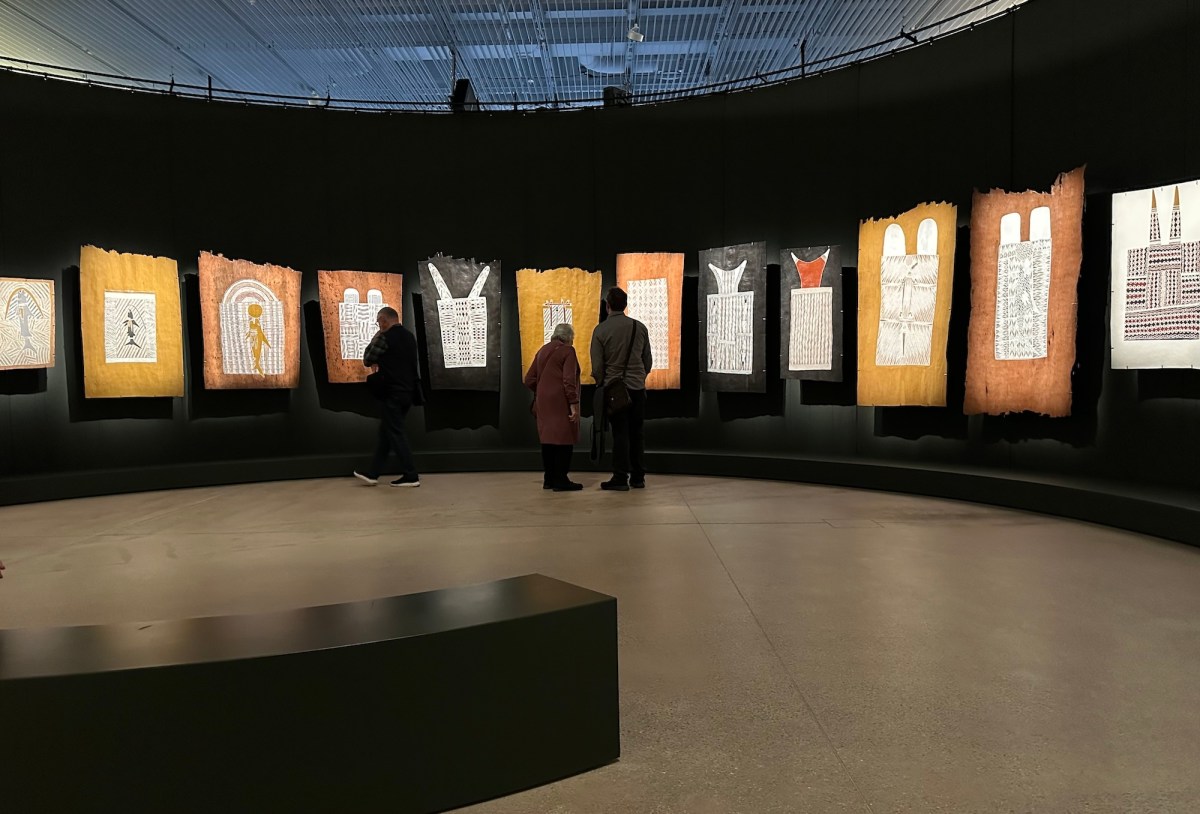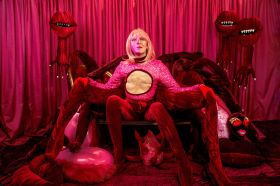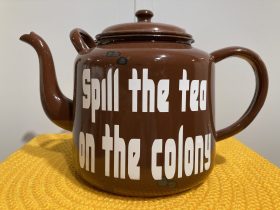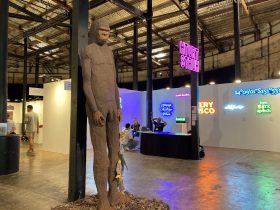Aboriginal and Torres Strait Islanders readers are advised that the following article contains references to deceased persons.
Located in north-east Arnhem Land, the Aboriginal-owned Buku-Larrŋgay Mulka Centre – a partner in this exhibition – is arguably the most successful art centre in Australia today. In part, that stems from the fact that this community of artists has embraced an commercial engagement since the mid 1930s – a self-determination along with a kind of brand of innovation that it has nurtured since the 1950s.
It is a remarkable story, that is mapped out in a new exhibition at the Art Gallery of NSW, Yolŋu power: the art of Yirrkala, one that is less interested in a rigorous chronology over eight decades and, rather, takes a deep dive into the trigger moments that ushered forward change.
The exhibition is exhaustive – almost 300 artworks – and draws upon important linkages between intergenerational storytelling and making. Often the work of a senior artist will be shown alongside their children, and then their children, showing the through line of clan designs, but also how that has evolved.
The exhibition starts with a video work by Ishmael Marika, Wunya’Gali (The Other Side) 2017, which posits a window to everyday life in this community. His words – printed on the entry wall – invite viewers to, ‘slow down, walk with us’. This welcome text is paired with a repurposed roadside stating ‘Road closed due to ceremony’ manipulated by Wanapati Yunupiŋu for the work Birimbira (2020). It sutures the past and the present in an inseparable visual language and is a great clue as to how to read the works that lie ahead for viewers.
Curated by Cara Pinchbeck – the Gallery’s head of First Nations – the exhibition starts by locating audiences in this timeless presence. A darkened gallery space carries barks with the emblematic design of each of the 16 clans – Miny’tji – assembled like a parliament of governance. The barks in this Rumbal series (2022-23) have the bodily quality of designs upon torsos. It is a very powerful room, and one feels like the communion of knowledge and consent.
These designs are not only the foundation of this exhibition, but the foundation of Yolŋu culture, and the exhibition steps more formally through what that means in terms of an evolving art movement and market.
It is appropriate that the Gallery places itself upfront in this narrative. In the 1950s, then Director of the Arts Gallery of NSW (AGNSW) Tony Tuckson collected key Yolŋu barks and sculptures from Yirrkala – the first to do so in Australia – to be shown alongside ‘other’ art. Visitors have the privilege of an intimate viewing of these early barks, including four by Mawalan Marika, Djaŋ’kawu creation story (1959) alongside creation barks by Mathaman Marika and Muŋgurrawuy Yunupiŋu. Their detail is mind-blowing in its finesse.

Mawalan Marika was a key senior man leading the decisions that shaped the trajectory of Yirrkala today. He had invited the Reverend Wilbur Chaseling to establish a mission in 1935, explicitly to sell the community’s artworks as a commercial enterprise. It was significant in that this was about a cultural livelihood and the ability to practise culture in a mission environment – a model that largely did not extend to other missions – and also was the foundation for what would become the art centre today.
That sense of empowerment and self-determination led to Yolŋu artists increasingly finding their political voice regarding land custodianship, painting the Church Panels in 1962 and the Näku Dhäruk (Bark Petition) in 1963 to assert their sovereignty. While these pieces are not in the exhibition, a number of barks from this period are in the next gallery space, including important pieces by Narritjin Maymuru, who was a driving force.
With the closure of the mission in 1974, his vision for a Yolŋu-owned business to sell their art was realised in 1976.
As one of the artists who painted the petition, Narritjin Maymuru also travelled to Sydney to see Aboriginal art presented alongside non-Aboriginal art, and returned to open his own gallery in Yirrkala. These were radically powerful moves, and this started to also manifest in the way these artists painted.
Here in this gallery, the first impression is the overwhelming scale of some of the barks and the larrakitj (ceremonial hollow log). It is a real treat to see them. Typical of the 1990s, when everything was aiming to be big, important collections such as the Telstra and Wesfarmers Aboriginal Art collections were also emerging as a new wave of ambitious collecting at an institutional and corporate level. Here visitors start to grasp that ambition and the assertion of Yolŋu power into the broader art world.
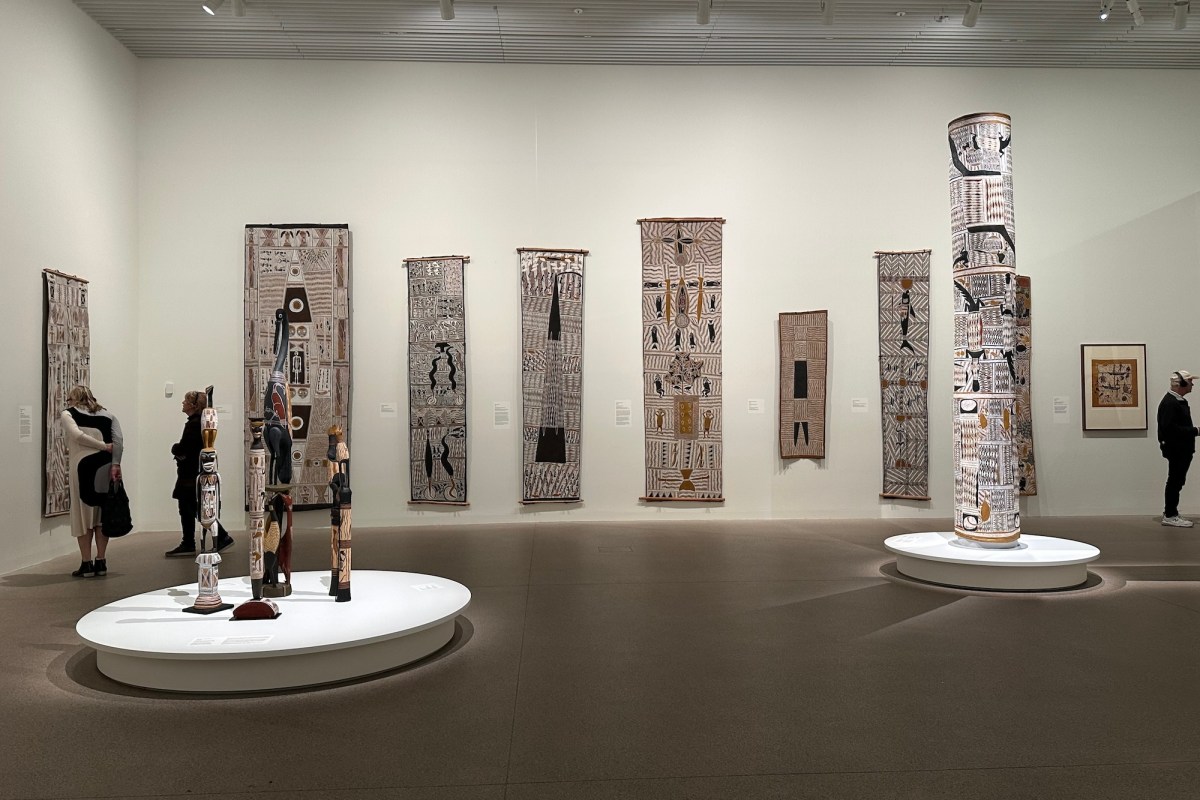
It was also this generation that actively started to encourage their daughters to paint – another radical break from tradition and one that would usher in an exciting future. Audiences see that story evolve through the Saltwater Collection (1997–1978), where women from all clans were encouraged to paint by Djambawa Marawili AM. A key piece here is, Living by the Sea (1998) by Marrnyula Munuŋgurr, which removes the clan designs from the background, presenting just everyday life.
It bridges this historical narrative to the next gallery, painted a soft mint green, where viewers are witness to the transition from bark to paper, mapped out with a selection of the first works done on brown paper with vibrant crayon – The Yirrkala Drawings – made in 1946. They are just as exciting today as the day they were made, when they opened a whole new world of expression through colour, and were a pathway to the Yirrkala Print Space (formed in 1995).
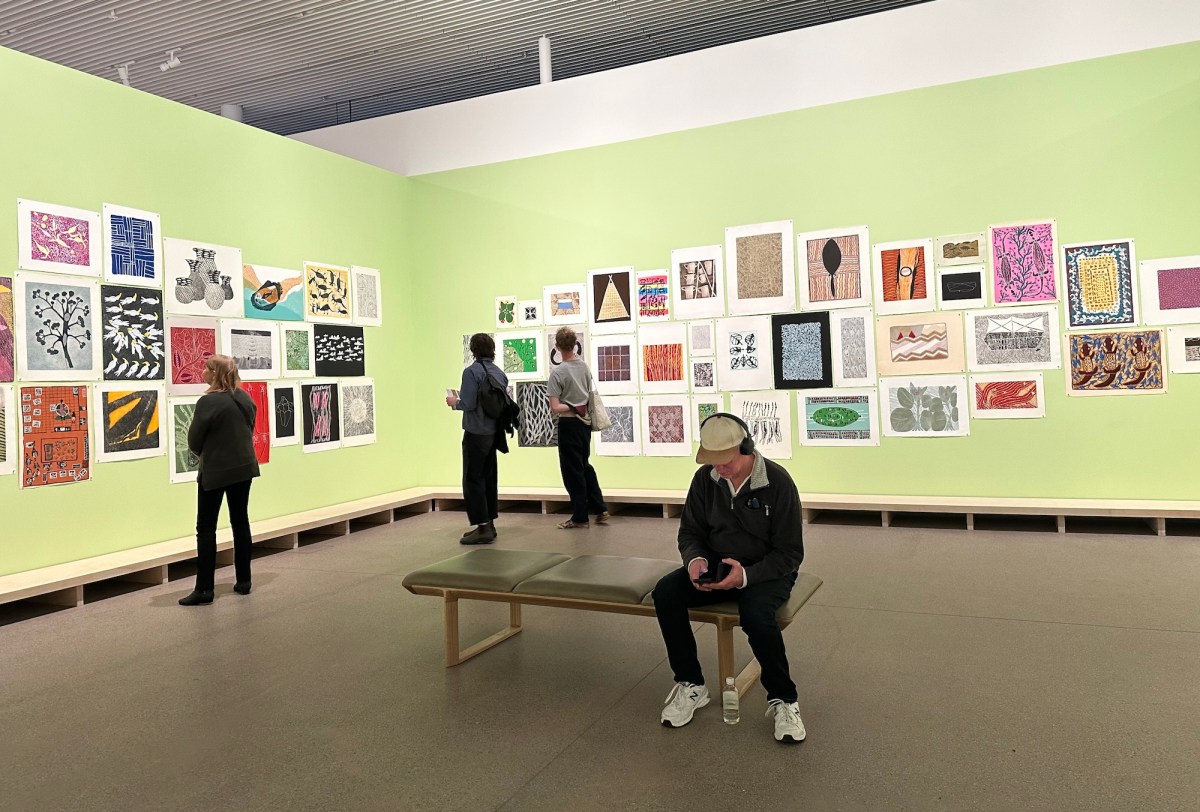
It had been decided (by the senior men) that due to the replication of printmaking, and not using materials from Country, clan designs were not appropriate. Viewing this suite of prints today, by both established and emerging artists, it is a clear narrative for audiences to see the seismic impact of that breakaway moment.
Continuing to move through the gallery spaces these narratives of past to present lineages continue, subtly drumming into visitors that this is an ongoing, living culture. A highlight in the next space is a large, suspended canvas by Nyapanyapa Yunupiŋu, Ganyu (stars) (2019), which presents her iconic natural pigments on one side, with a digital projection on the reverse. It leads to what could be considered the heartbeat of this exhibition – an immersive digital installation, Rarrirarri (2023). This re-enlivens the drawings of Mulkuṉ Wirrpanda, and animates trails of plants and arts that envelop a termite mound. It is an extremely complex piece of time-based art-making, and offers a stunning visitor experience.
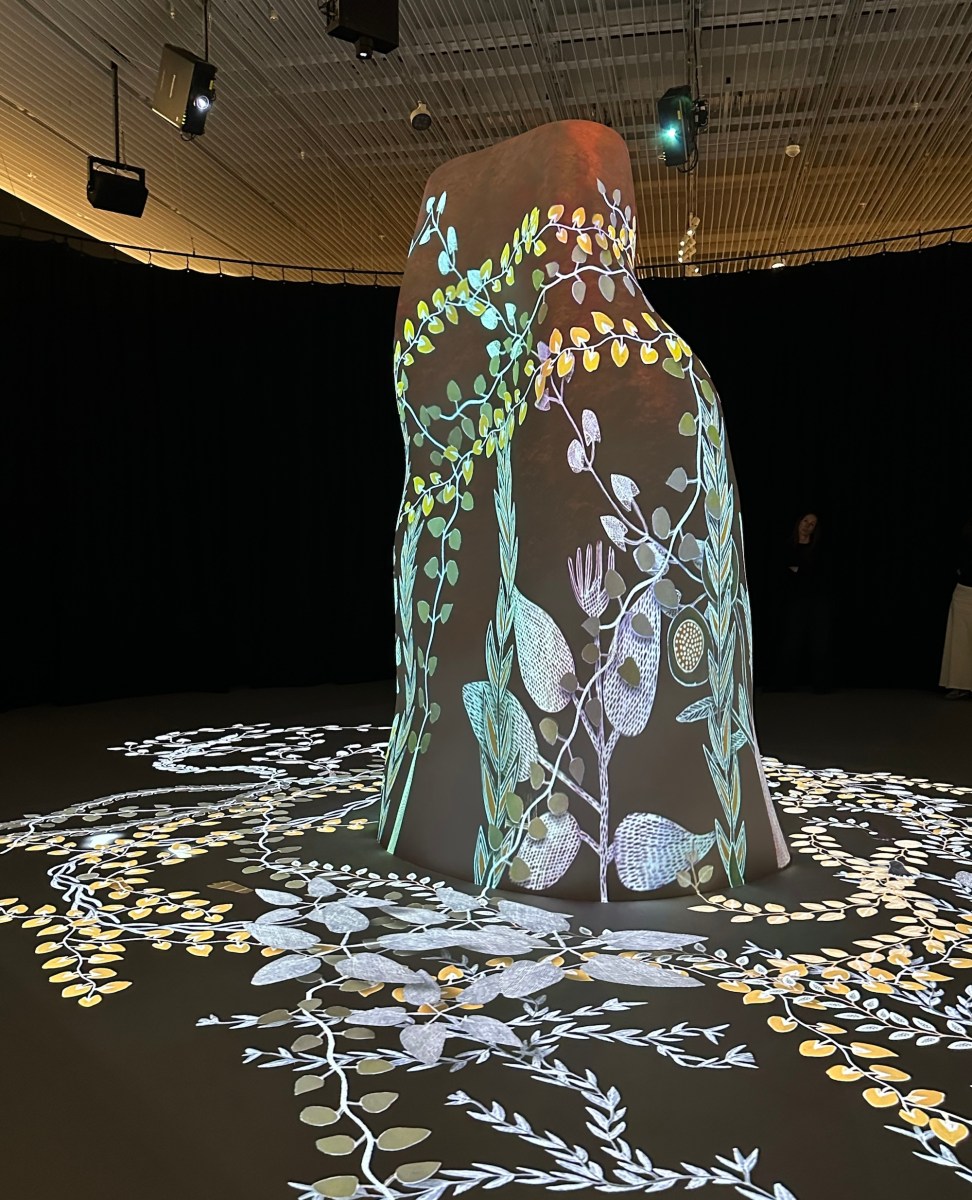
A soundscape of Mulkun Wirrpanda singing with her family resonates across the whole gallery, connecting all the clans presented. What is especially fabulous about this project is the way it uses archival material after her passing on. Produced by The Mulka Project (founded in 2007), it challenges how archives can be activated, and arguably is leading in this space today.
Read: Exhibition review: Cerith Wyn Evans …. in light of the visible, Museum of Contemporary Art
The exhibition continues to move through more recognised innovative practice in recent years – Noŋgirrŋa Marawili’s use of pink spent printer ink cartridges on her barks, the use of found metal sheet and rubber from deserted mining plants by Gunybi Ganambarr and a large-scale free-standing sculpture by Wurrandan Marawili. This final space of Yolŋu power is the most obvious display of innovation, and in some ways is almost a pared back focus by Pinchbeck.
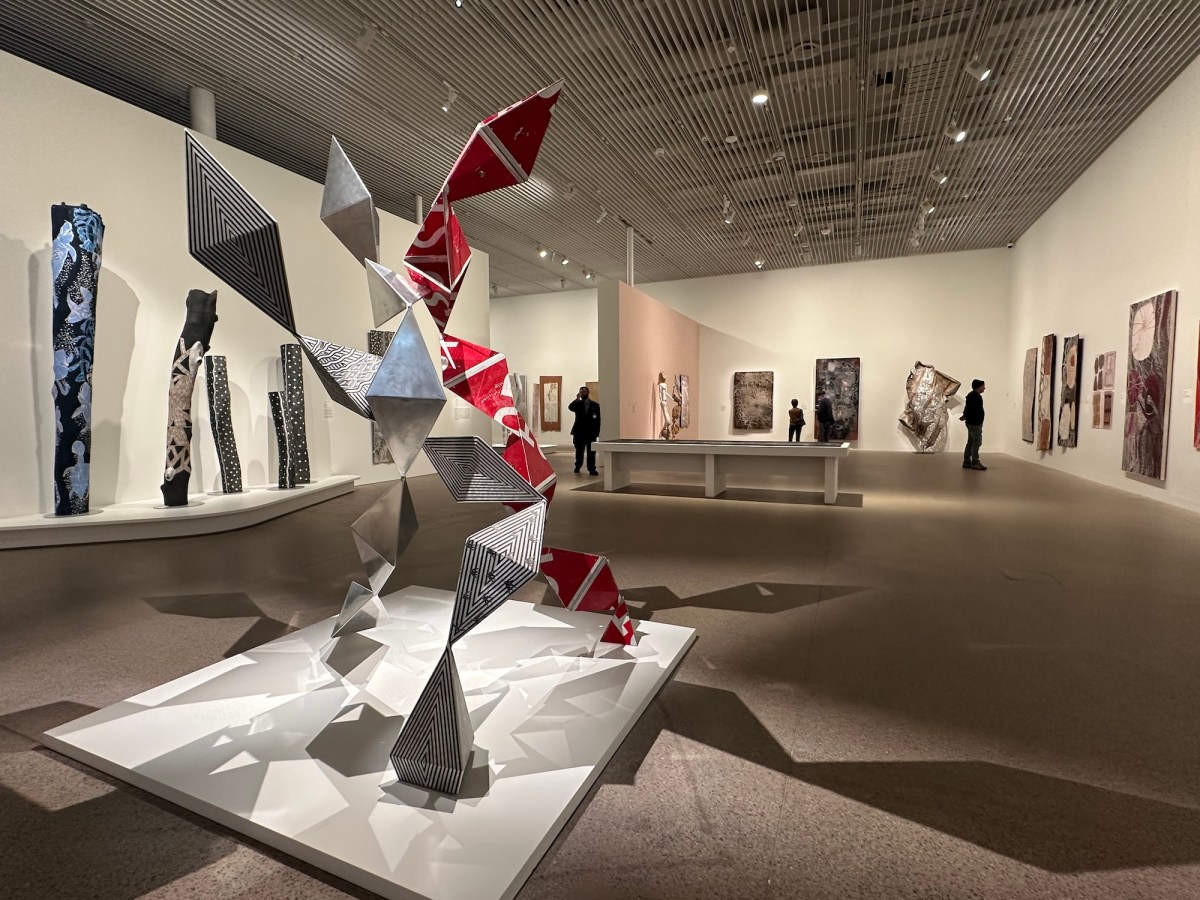
This allows people the ‘slow time’ – to recall Ishmael Marika’s video and welcome text – to understand the longer tail of this story of Yirrkala.
This exhibition is a must. It is far more than just a survey of the oeuvre of a group of artists. It rewrites our understanding of Aboriginal art and its enduring impact, and power, in Australia.
Yolŋu power: the art of Yirrkala
Art Gallery of NSW
Ainsworth Family Gallery in Naala Badu
Curator Cara Pinckbeck
In partnership with Buku-Larrŋgay Mulka Centre
21 June to 6 October 2025
Ticketed
Discover more arts, games and screen reviews on ArtsHub and ScreenHub.
